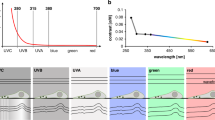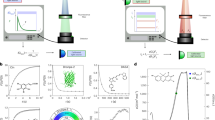Abstract
ULTRA-VIOLET light has been used in microscopy mainly because it makes possible the study of the distribution in cells of absorbing substances, such as nucleic acids, proteins and organic iodine compounds. There has, however, been controversy about the ultra-violet absorption of living cells since Brumberg and Larionow1 questioned the findings of earlier workers2 and suggested that living cells have only a very low absorption around 2600 A., which increases markedly after a few minutes irradiation. The elegant photographs of Ludford, Smiles and Welch3, on the other hand, indicate that fresh cells of the Rb tumour show marked nuclear and cytoplasmic absorption when first observed at 2570 A. and 2750 A.
This is a preview of subscription content, access via your institution
Access options
Subscribe to this journal
Receive 51 print issues and online access
$199.00 per year
only $3.90 per issue
Buy this article
- Purchase on Springer Link
- Instant access to full article PDF
Prices may be subject to local taxes which are calculated during checkout
Similar content being viewed by others
References
Brumberg, E. M. and Larionow, L. T., Nature, 158, 663 (1947).
Wyckoff, R. G. W., Ebeling, A. H. and Ter Louw, A. L., J. Morph., 53, 189 (1932). Caspersson, T., Symp. Soc. Exp. Biol., 1, 127 (1947).
Ludford, R. J., Smiles, J., and Welch, F. V., Nature, 162, 650 (1948).
Gersh, I., and Baker, R. F., J. Cell. Comp. Physioil., 21, 213 (1943).
Mitchell, J. S., Brit. J. Exp. Path., 23, 285 (1942).
Davidson, J. N., Cold Spring Harbor Symp., 12, 51 (1947).
Hollaender, A., Greenstein, J. P., and Jenrette, W. V., J. Nat. Canc. Inst., 2, 23 (1941).
Loofbourow, J. R., Cook, E. S., and Stimson, M. M., Nature, 142, 573 (1938). Hevesy, G., and Zerahn, K., Acta Radiol., 27, 316 (1946).
Brachet, J., “Embryologie Chimique’ (2nd edit., 1945).
Chalkley, H. W., Protoplasma, 28, 489 (1937).
Henry, H., and Stacey, M., Proc. Roy. Soc., B, 133, 391 (1946).
Author information
Authors and Affiliations
Rights and permissions
About this article
Cite this article
BRADFIELD, J., ERRERA, M. Ultra-Violet Absorption of Living Cells. Nature 164, 532–533 (1949). https://doi.org/10.1038/164532a0
Issue Date:
DOI: https://doi.org/10.1038/164532a0
This article is cited by
-
Computational On-Chip Imaging of Nanoparticles and Biomolecules using Ultraviolet Light
Scientific Reports (2017)
-
Die UV-Absorption in Spinalganglienzellen vom H�hnerembryo in vitro
Zeitschrift f�r Zellforschung und Mikroskopische Anatomie (1955)
Comments
By submitting a comment you agree to abide by our Terms and Community Guidelines. If you find something abusive or that does not comply with our terms or guidelines please flag it as inappropriate.



